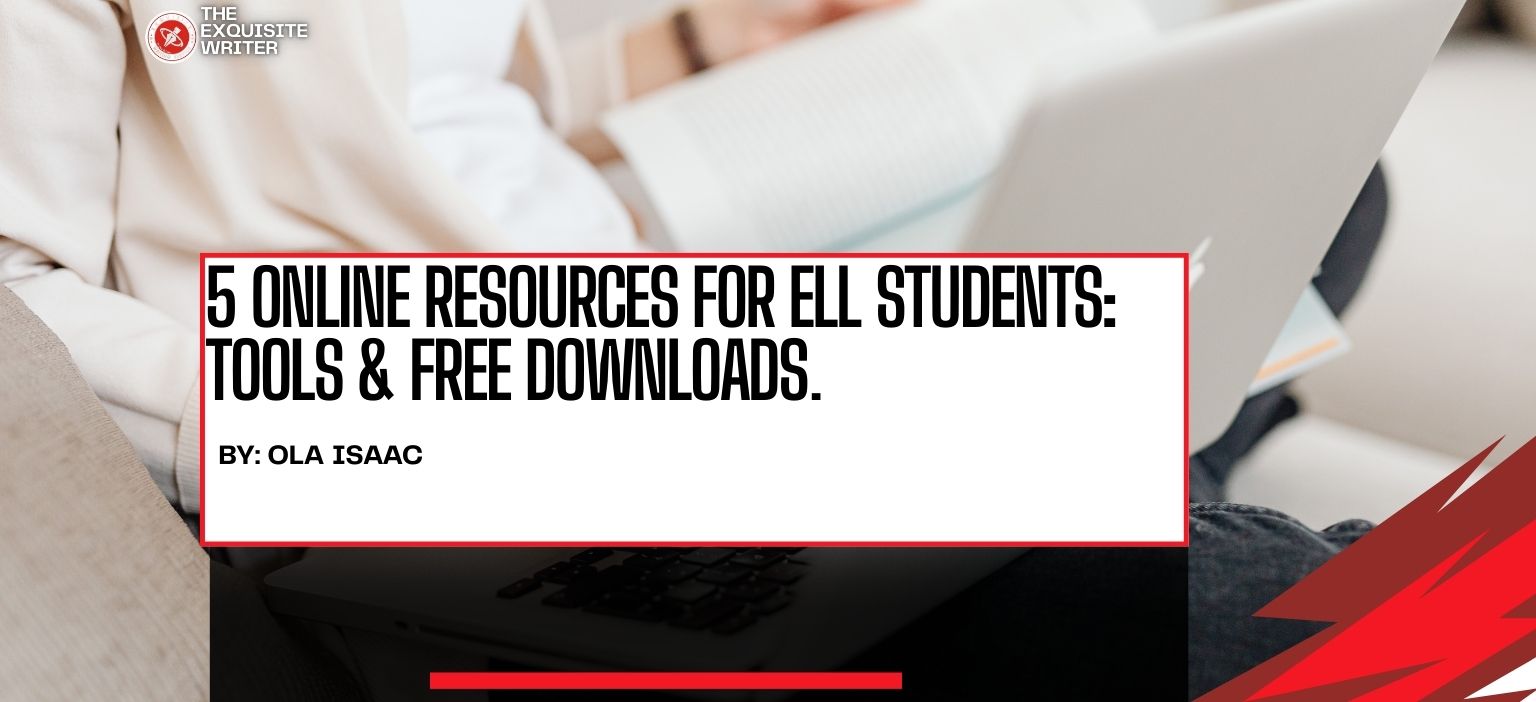English Language Learners (ELLs) struggle with unique challenges—from mastering vocabulary and grammar to understanding cultural nuances in communication.
Thankfully, the internet is home to a wealth of online resources for ELL students!
These online resources outlined in this article would make English language learning accessible, engaging, and effective.
Research indicates that online resources are highly effective in enhancing English Language Learner (ELL) students’ language proficiency, motivation, and engagement.
Thus, whether you’re a teacher, student, or parent, our guide will take you through some of the most helpful online resources for ELL students.
We’ve also added a free ELL strategies list PDF to support structured learning.

Why Online Resources Matter for ELL Students
In today’s internet age, online tools are more than simply an extra study option. They are a complete game-changer for English Language Learners (ELL).
They help fill the gaps left by traditional classrooms and present solutions matching the pace and challenges that modern life brings.
Therefore, if you are a student balancing multiple subjects, a busy adult learner, or someone studying English from halfway across the globe, online resources offer the flexibility, access, and variety you need to succeed.
Here’s why they make such a difference:
- Flexibility. With online resources, you can learn anywhere, anytime.
There is no need to wait for a scheduled class. Whether you have 5 minutes on your break or an hour before bed, you can log in and practice at your pace.
Downloadable worksheets, mobile apps, and cloud-based tools mean your learning materials will always be at your fingertips—whether you’re commuting, at home, or traveling.
- Interactive practice. Online resources make learning engaging.
Quizzes, videos, gamified lessons, and interactive stories can turn learning into something appealing and something you look forward to, not dread.
For example, you can explore platforms like BBC Learning English and Duolingo to keep lessons engaging and short while tracking your progress. These activities mimic real-life scenarios. As a result, you can test your knowledge in a safe, low-pressure environment.
- Personalization. Online resources allow learning to be tailored to your needs.
Several online programs utilize adaptive learning technology to assess your skill level and automatically adjust lesson difficulty.
If you are having problems with grammar but excel in reading comprehension, these platforms will address your weak spots while helping you be motivated with topics you enjoy.
- Access to authentic language. English language learners who opt for online resources get access to real-world English exposure.
They often feature native speakers in podcasts, videos, and live conversation sessions. What does that mean? This means you’re not just learning textbook English. It also means you’re hearing and practicing the language as it’s used in daily conversations, business meetings, news, and entertainment.
Exposure to authentic slang, accents, and cultural references helps individuals communicate confidently in real-world situations.
While online learning is excellent, combining online learning with offline practice is key. Therefore, use apps for daily drills.
Nonetheless, watch movies without subtitles, read English articles, or speak to a friend in English to reinforce the lessons you’ve learned.
So now let’s explore these five online resources for ELL students.
Read: Debunking 15 Famous Writing Myths
Five Online Resources For ELL Students
Here are the five online resources for ELL students.
1. Vocabulary-Building Resources
The foundation of English fluency is building a strong vocabulary.
The more words students know and understand in context, the easier it will become to write, read, listen, and speak with confidence.
Here are vocabulary-building resources:
a. Quizlet
Quizlet is one of the most famous vocabulary tools for ELL students.
It allows learners to choose from thousands of pre-made English learning sets and create their digital flashcards. Each card can include:
- Images to connect meaning visually.
- Audio pronunciation to listen to words spoken correctly.
- Example sentences for real-world context.
With this resource, ELL teachers can create class sets for unique topics, such as “Travel English,” or “Common Academic Vocabulary,” while students can track their mastery through games and built-in quizzes.
Note: Use the “Learn” and “Test” modes often to reinforce long-term retention and not simply short-term memorization.
b. Vocabulary.com
This website is one of the online resources for ELL students; It takes a unique approach—it learns from you.
As you answer questions, this resource adapts to your skill level, familiarizing you with words that challenge you without burdening you.
It’s particularly helpful for:
- Idiomatic expressions that aren’t common in traditional word lists.
- Academic vocabulary is often found in standardized tests and textbooks.
- Context learning through clear, short explanations and sample sentences.
The site also presents vocabulary lists based on exams, books, and subject areas, making it perfect for ELL students preparing for IELTS, TOEFL, or other assessments.
The Exquisite Writer recommends that you pair these tools with a printed vocabulary tracker.
It can be a simple downloadable sheet or notebook where you record new words, their meanings, and your example sentences. Writing them by hand helps with reinforcing memory.
2. Grammar and Writing Support
Even with a strong vocabulary, ELL students require clear grammar and writing skills to help communicate effectively. These tools offer targeted support to help avoid common mistakes and polish writing.
These tools are:
a. Grammarly
Grammarly is a free AI-powered writing assistant that checks for:
- Word choice improvements
- Grammar and punctuation errors
- Sentence clarity and tone suggestions.
ELL students worldwide have acknowledged that they greatly benefited from instant explanations. Grammarly doesn’t only flag an error; it explains why it’s wrong and presents a fix.
With time, this helps learners identify and correct mistakes on their own.
With the premium version, you can even enjoy advanced writing feedback for professional and academic contexts.
b. Purdue OWL (Online Writing Lab)
This is a free, comprehensive resource that covers all aspects of writing, from simple grammar rules to advanced research formatting. It’s practically helpful for:
- Understanding essay formats (APA, MLA, Chicago style).
- Learning sentence structure and parts of speech.
- Reviewing writing tips for non-native speakers.
ELL teachers can assign OWL exercises as homework or utilize them in class for guided practice.
Related: Weekend Grammar Game: Can You Spot the Error?
3. Listening and Speaking Practice
Strong listening and speaking skills are key for real-world communication.
These tools assist ELL students to hear authentic English, build confidence in conversation, and practice pronunciation.
a. BBC Learning English
BBC Learning English presents simple, short, and well-structured audio and video lessons with matching transcripts. This will help learners read along as they listen.
Key benefits include:
- A wide array of topics, ranging from everyday conversations to business English and news.
- Varying accents that will help learners get comfortable with American, British, and other varieties of English.
- Grammar and vocabulary integration lessons that naturally include explanations of new phrases and words.
When you are exploring this tool, listen once without the transcript. Then do the same while reading it. This trains the ear to catch more words with time.
b. ESL Fast
ESL Fast contains more than 1,000 free conversations, each with audio and text. Lessons are designed for smart and practice—excellent for short study sessions.
Why this works for ELL students:
- Sentences are clear and short, making them easy to imitate.
- Audio is slightly slower than native speed, allowing learners to pick up pronunciation details.
- Topics cover daily life situations, from job interviews to ordering food.
Professional Tip: Repeat sentences out loud, imitating the speaker’s rhythm and intonation. This “shadowing” technique enhances fluency naturally.
4. Reading Resources
Reading builds grammar awareness, vocabulary, and comprehension skills. These platforms make it simpler and easier for ELL students to access texts at the right difficulty level and enjoy the process.
a. Newsela
Newsela adapts real news articles to different reading levels, helping students to choose the complexity that aligns with their skills.
Benefits for ELL learners:
- Adjustable difficulty. This means that the same story can be read at a beginner or advanced level.
- Wide range of topics. This includes science, sports, culture, politics, and more.
- Built-in quizzes to verify understanding.
- Teachers are able to assign the same article to a mixed-level class and have everyone read at their pace, making sure that no student feels left behind.
b. Storynory
Storynory offers free audio stories with matching text, covering everything from classic literature to fairy tales.
Why ELL students love it:
- Narration is expressive and clear, perfect for enhancing listening skills while reading along.
- Stories are organized by difficulty. That means that beginners can start with short fables, while advanced learners can tackle longer classics.
- The combination of vocabulary exposure and storytelling makes learning feel like entertainment rather than studying.
Make sure you listen to the audio first, then read the text next. Finally, listen again—this strengthens both pronunciation and comprehension.
5. Interactive Learning Platforms
Interactive platforms keep motivation high and make learning English engaging. By adding leaderboards, game-like features, and challenges, they help ELL students stay consistent while having fun at the same time.
a. Duolingo
Duolingo is an app that turns language learning into a game.
Why it is perfect for ELL students:
- It comes with streak tracking that encourages daily use, which is key for language retention.
- Its short, bite-sized lessons keep practice manageable.
- Progress milestones that give learners a sense of achievement.
- Lessons cover grammar, vocabulary, listening, and speaking, with immediate feedback.
Professional Tip: Use Duolingo alongside a notebook. Write down each new word or phrase you learn. This extra step will help you transfer knowledge to long-term memory.
b. Kahoot!
Kahoot! offers a fun, competitive edge to English learning.
Why ELL students benefit:
- It comes with custom quizzes that can be tailored to grammar, vocabulary, or comprehension skills.
- It is perfect for solo practice at home or group learning in classrooms.
- The game format makes even tricky topics enjoyable.
Teachers can design Kahoot! Games are based on the week’s lesson, while students can create their own quizzes to test themselves or their classmates.
Free Download: ELL Strategies List PDF
To make your ELL journey smoother, we’ve compiled a free ELL Strategies List PDF. It is a practical guide to keep on your phone or print for daily reference.
Inside you’ll find:
- Listening and speaking drills to do alone or with a partner.
- Cultural immersion suggestions to help you think in English.
- Daily vocabulary practice tips for faster word recall.
- Reading comprehension activities for all skill levels.
- Self-assessment checklists to track your growth week by week.
How to Maximize Online Resources
Even the best tools will not help you much without a smart approach. Employ these strategies to help you get the most out of your online learning time:
- Set clear goals: Decide on a weekly skill goal and target. For example: “Learn 30 new words” or “Listen to 4 English podcasts in a month.”
- Mix formats: Rotate between reading, listening, writing, and speaking tools to build balanced skills.
- Track progress: Be sure to keep a simple log of your daily activities and check your improvements often.
- Stay consistent: 15–30 minutes a day is better than long but irregular study sessions.
- Review often: Don’t neglect your older material to reinforce memory before moving on.
How Community and Peer Support Can Help ELL Students
While online tools are incredible tools for self-paced learning, human interaction is an irreplaceable channel when it comes to mastering a language.
Connecting with other learners—or even with native speakers will help you practice real-life conversation, stay motivated through shared progress, and learn cultural nuances.
It also fosters accountability, as knowing others are learning alongside you makes you feel more committed.
Where to get started:
- WhatsApp or Facebook groups for ELL students: On the website, search for groups based on your country or city. These often post practice challenges, share resources, and arrange casual meetups (both in person and online).
- Reddit communities: You can explore Subreddits like r/EnglishLearning or r/English. These offer global peer discussions where an individual can share study tips, ask grammar questions, or engage in writing challenges.
- Language exchange platforms: Apps like HelloTalk, Tandem, or Speaky connect you with native English speakers who want to learn your language in exchange. These exchanges are a win-win—you get speaking practice, and they get to learn from you.
- Community center events or Local library: Many libraries host free language cafés or English conversation clubs where learners meet to talk in English over coffee or tea in a relaxed setting.
How to make the most of community learning:
- Don’t be shy – You will make mistakes. But it’s part of the learning process. Every error allows you to improve.
- Be consistent – Join regular group sessions or schedule recurring language exchanges to maintain steady progress.
- Set a challenge – For example, focus more on speaking only English during a weekly video call with your group.
- Offer value back – If you’re in a language exchange, assist your partner with their target language too. This will build stronger connections.
Impressive Tips: Pair online study with real interaction. Writing, reading, and listening will build knowledge. However, speaking to people in English will transform passive skills into fluent communication.
In fact, 15 minutes of live conversation can be more efficient than an hour of silent study.
Next: 25 Best Free Offline Writing Apps to Enhance Your Productivity
Final Thoughts
The right online resources can transform English learning, making it faster, easier, and more enjoyable.
By combining vocabulary tools, grammar support, interactive platforms, and your free strategy PDF, you’ll build confidence and fluency step by step.
Keep learning consistently, stay patient with yourself, and celebrate each improvement.
Every minute you invest moves you closer to mastery.

